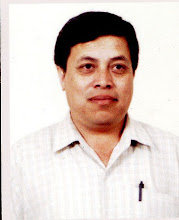Flood
It is overflow of water from river, stream etc into nearby land. It occurs when vegetation and soil can absorb all of the rain water.
Causes
o Heavy rain fall during monsoon.
o Snow melt
o Glacier lake outburst (GLOF) common in mountainous country
o Urbanization , ground surface becomes impermeable to water.
o Earthquake tidal moves generated by quake cause flood , tsunami.
Types
Periodic flood which occur naturally in many river during the monsoon.
Flash flood which occur rapidly flood rises and falls without warning. It is resulted from heavy rain over a small area or GLOF or dam failure.
Effects
Destruction of agricultural crops like rice , potato etc
Destruction of property, disease like cholera typhoid dysentery etc.
Death loss of life of man and animals
Loss to government, damage to roads, buildings, telephone electrical infrastructure.
Land slide
Down ward and upward movement of slope forming materials like rock soil etc. It is caused by falling sliding flowing at faster rate. It occurs in steep slopes where hard and heavy rock overlies softer ones.
Causes
o Natural factor, steep slopes, development of weak rocks, high weathering of rock, heavy rain fall seismic activity.
o Anthropogenic factors, deforestation, over grazing, agricultural activity on steep slope, construction of roads, building canals etc are artificial factors which cause landslides.
Effects
High amount of fertile soil washes down leaving unproductive land or area.
Destroy ecosystem of area.
Destroy road and building.
Blocks stream, river etc cause huge flood.
Landslides in public settlement take life and property.
Terrestrial animals are highly affected.
Streams or river may dry out or appear in improper places.
Earth quake
Sudden temporary vibrations set up on earth’s surface ranging from a faint tremor to a wild motion. The motion is due to sudden release of energy stored inside the earth surface. It lasts from a few seconds to a minute. Sometimes the vibrations are so feeble that we cannot feel them.
Terms
Focus/hypocenter - it is the point under the earth from where the earth waves originate the earth quake.
Epicenter – it is the point on the surface of earth directly above the focus of a earth quake. This is the most affected area during the earth quake.
Causes
o Natural cause
Tectonic cause - about 95% if the earth quake are due to crack or fracture developed on a rock by accumulation of more stress, dislocation of rock and waves of energy are sent out through earth.
Non tectonic – explosion of volcano etc.
o Anthropogenic - some earth quakes are caused due to human activity like underground explosion of bombs, passage of trains and tank, heavy machinery in indusrial area, extraction of mines, minerals and fossil fuels from earth’s crust, fracture of dam and collapsing of large buildings etc.
Effects
Due to vibrations of ground, the infrastructure got heavily damaged. It can take life of people.
Earth quake also changes geological structures of an area and destroys road, water and gas pipes.
Responsible for fire due to fallen wires and broken gas pipes.
Earth quake below sea generates seismic waves causes tsunami.
Causes landslides and flood.
Fore shock- minor shock which occur before major earth quake.
After shock- minor but destructive earth quake which occur after major earth quake.
Seismograph – it is the graphic representation of measurement of origin and frequency(the magnitude of earth quake).
The largest earth quake so far measured is 8.6 in Richter scale.
Prof. Charles Richter of California proposed a scale of earth quake magnitude in 1935 AD to measure the quantity of energy released during earth quake.
Role of forest
1. Timber and wood collection for building and industries.
2. Firewood consumption, rural people about 80% depend upon fire wood.
3. Industrial raw material like paper industry lokta plywood dyes resins gum turpentine etc.
4. Ecological balance.
5. Maintenance of global climate, absorb CO2.
6. Check soil erosion, landslide, land degradation.
7. Sources of medicinal plants, essential oil, used in soap cosmetics and pharmaceuticals etc.
8. Habitat for wild animals
9. Beauty, natural beauty tourism industry, visit forest for peace and recreation.
10. Fodder
11. Ornamental and religious
12. Fruits
Role of river
Water is the most important component for life. Cells and tissue of animals and plant body contain 60 to 90 % of water. Plants use water as raw material for photosynthesis, water essential for cooking and washing, bathing etc.
1. Sources for water supply in urban area.
2. For irrigation (agriculture)
3. Power industry (boiler)
4. Habitat for fresh water and marine water animals.
5. Beauty
6. Hindu rituals cremation in the bank of river.
7. Generate electricity
8. Water mill
9. Control pollution
10. Civilization, settlement eg Nile river.

No comments:
Post a Comment